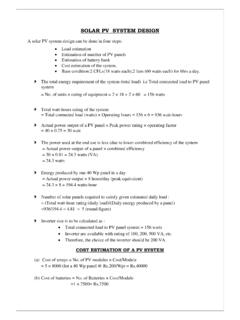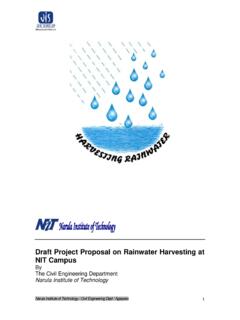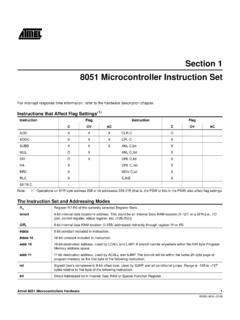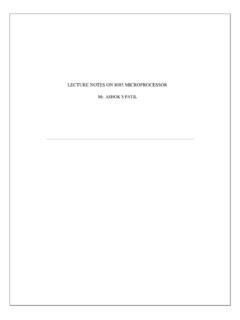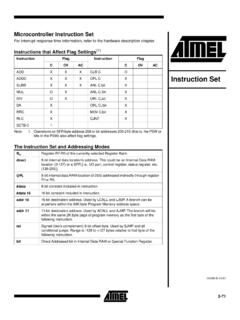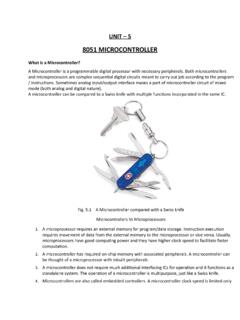Transcription of BASIC ELECTRONICS LAB - Narula Institute of Technology
1 Narula Institute OF Technology . Department of ELECTRONICS & Communication LAB PROFILE. BASIC ELECTRONICS LAB. Objectives: This is a first level laboratory in which students are introduced with ELECTRONICS & Communication Engineering for the first time and are trained with preliminary of ELECTRONICS . Experiments: Training in this laboratory is done through properly planned structured programme with the following sequences: i) Introduction and identification of different active and passive electronic devices / components. ii) Familiarization with different signal sources and instruments used in electronic engineering.
2 In the process student can learn the significances of the manufactures specifications etc. iii) To learn the use/ handling of different measuring instruments like multimeters, etc. iv) Find and studies on the various characteristic of different active devices like diodes (PN. Junction Diode, Zener Diode, LED) transistors, field effect transistor, Photodiodes and to determine the different parameters of these devices v) To recognize Half Wave & Full Wave rectified sinusoidal signal & find out different parameters. vi) Familiarization with op-amp & measurement of it's different parameters.
3 Vii) Implementation of different logic gates & Boolean functions using different Ics. Facilities available: 1. In this laboratory there are sufficient number of working benches (nearly 10), so that the students can work comfortably. Each of the benches are fully equipped with: a) Signal sources b) Power supply c) Measuring instruments like digital multimeter, etc. 2. There are two working benches are set aside for assembly of circuits, with facilities of soldering and desoldering, electronic tool kits etc. Major Equipment in the Lab 1. Various power supplies fixed and variable variety with different current rating.
4 Make . Enova, Aplab etc. Some of the power supply are in use designed and fabricated technical staff of the department. 2. Digital multimeters (Mastech ,Vartech). 3. Cathode ray oscilloscope (Scientech). 4. Function Generator (Scientech). 5. Regulated DC power supply (Scientech). 6. FET Test Set (Detech, Scientech- Nvis Technologies). 7. PN Junction Diode / Zener Diode Test Set (Detech, Scientech- Nvis Technologies). 8. Op-Amp Power Supply (Sushma ELECTRONICS ). 9. Rectifier Test Set (Detech, Scientech- Nvis Technologies). 10. Op-Amp Test Set (Microtech Industry).
5 11 Transistor Test Set (Detech, Scientech- Nvis Technologies). 12 Multi power Supply (Scientech). General information about the laboratories: 1. Before starting of the laboratory the students are instructed with necessary safety and precautionary measures that has to be adopted in any electrical laboratory. 2. Well designed laboratory manual / instruction sheets are provided to students at the beginning of the session for a particular lab. 3. Laboratory is maintained and conducted by well trained technical supporting staff under the supervision of the faculty members.
6 4. Most of the technical staffs have undergone first aid and fire fighting training. DIGITAL ELECTRONICS LAB. Objectives: Digital ELECTRONICS is Technology subject which is intended to make students familiar with different types of designs as sequential logic circuits, combinational logic circuits, trouble shooting of various digital systems & study of various digital systems. Knowledge of BASIC ELECTRONICS & digital techniques is useful in understanding theory and practicals of the subjects. For years, applications of digital ELECTRONICS were confined to computer systems.
7 Today digital ELECTRONICS are applied in many diverse areas such as telephony, data processing, radar, navigation, military systems, medical instruments, process controls etc. Experiments: In this laboratory students are introduced with digital ICs and their specifications and are skilled with practical digital circuit design. Training in this laboratory is done with accurate planned structured programme with the following sequences: i) Introduction and identification of different digital IC chips and their specifications, concept of Vcc and ground, verification of the truth tables of logic gates.
8 Ii) To learn the use of different ICs and LEDs for designing logic circuit and verifying the results respectively. iii) Study of BASIC gate diagrams and realize the same with universal logic gates . iv) Realization of different codes and also the conversion technique like BCD to Excess-3 and vice- versa, BCD to decimal to drive 7-segment display using multiplexer etc. v) Construction of various combinational circuits such as adder, adder circuit using shift Register and full adder, subtractor, simple decoder, multiplexer, parity generator and comparator using logic gate ICs or any specific chip.
9 Vi) Study of the difference between combinational and sequential circuit and realize the need of function generator,CRO for the design of sequential circuits like RS-JK and D flip-flops using universal logic gates; universal Register using JK flip-flops and logic gates or using multiplexer and flip-flops ; asynchronous & synchronous up/down counter; ring counter and johnson's counter sequential counter with irregular sequences etc. Facilities available: Sufficient number working benches (more than 8) are there in this laboratory for the easiness of students work.
10 Each of the benches are fully equipped with: i) Power supply ii) Function Generator iii) etc. Major Equipment in the Lab 1. Fixed and variable Various power supplies (Elnova, Aplab). 2. Multiple power supply (Scientech). 3. Digital multimeters (Metravi,Mastech). 4. Function generators: (Aplab,Systronics,Intilect,Scientech). 5. Cathode ray oscilloscope (Aplab). 6. IC Tester: 7. Digital IC Tester (Minmax ELECTRONICS ). 8. Analog IC Tester (Minmax ELECTRONICS ). General information about the laboratories: 1. Before starting of the laboratory the students are instructed with necessary safety and precautionary measures that has to be adopted in any electrical laboratory.

